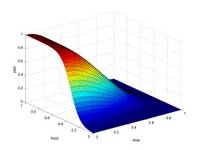Rosenberg's Theorem
Suppose P is the amount of pain one feels from an abdominal cramp. Let I be a weighting factor that is a function of speed, s, and distance, d, of a workout. The independent variable f is the amount of food one has eaten; the other independent variable t is the time elapsed between consumption of food and beginning the workout. The parameters C and F are constants that describe the shape of the response curves.
Given this information, it is possible to compute P for any given combination of amount of food eaten, time waiting after said food, and intensity of workout. Rosenberg's Theorem says that P takes the form:

The following plot shows the pain normalized for I = 1 and also normalized on the time and food axes:

Today, I had a big juicy cheeseburger for lunch, so f = 9 oz. I then waited until 3:30 pm to go for a run, so t = 2.5 hrs. It was a pretty swift run, as I had planned to keep a 7-minute pace for 4 1/2 miles, so I = 0.8 or so. Normalizing f and t, this would put my P-value easily in the red-orange range of the plot above.
Yum!
Ouch!




 Gears and Coffee
Gears and Coffee
1 Comments:
No comment.
What do you think?
<< Home